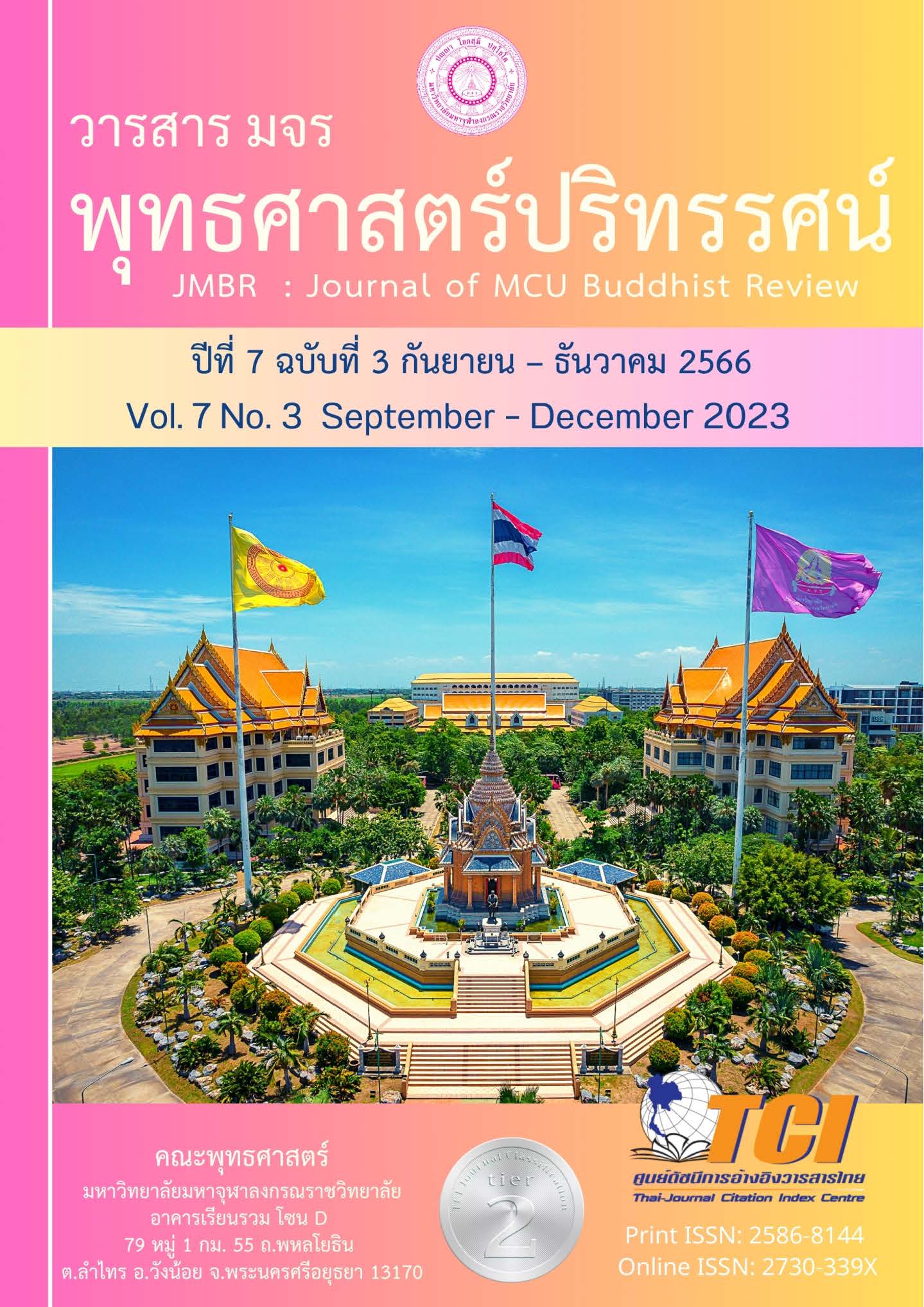การศึกษาเชิงเปรียบเทียบรูปแบบการอธิบายอัปปมาทธรรมในพระพุทธศาสนาเถรวาทและพระพุทธศาสนามหายาน
Main Article Content
บทคัดย่อ
บทความวิจัยนี้มีวัตถุประสงค์ 1) เพื่อศึกษารูปแบบการอธิบายอัปปมาทธรรมในพระพุทธศาสนา เถรวาท 2) เพื่อศึกษารูปแบบการอธิบายอัปปมาทธรรมในพระพุทธศาสนามหายาน 3) เพื่อศึกษาเปรียบเทียบรูปแบบการอธิบายอัปปมาทธรรมในพระพุทธศาสนาเถรวาทและพระพุทธศาสนามหายาน งานวิจัยนี้เป็นการศึกษาเชิงคุณภาพ โดยเน้นศึกษาข้อมูลเชิงเอกสารและการสานเสวนา วิเคราะห์และนำเสนอผลการวิจัยเชิงพรรณนา
ผลการศึกษาพบว่า 1) ความไม่ประมาทมีคุณค่ายิ่งในการดำเนินชีวิต จะต้องมีสติระลึกในการละเว้นจากความชั่ว และไม่ควรพลาดโอกาสในการทำความดีงามให้สมบูรณ์ที่สุดด้วยการรักษาศีลและบำเพ็ญบารมี 2) พระพุทธศาสนาเถรวาทและมหายานเน้นศีล 5 เป็นหลักจริยธรรมขั้นพื้นฐาน แต่พระพุทธมหายานได้เพิ่มหลักโพธิสัตวศีล บารมี 6 ของพระโพธิสัตว์เป็นวิถีฝึกหัดพัฒนาตนให้เป็นผู้มีสติคือไม่ประมาทหรือมีอัปปมาทธรรมและเกิดปัญญา พิจารณาสัจจธรรมตลอดถึงเจริญมรณัสสติเพื่อความสิ้นไปแห่งอาสวะกิเลสทั้งหลายด้วย 3) เมื่อเปรียบเทียบการอธิบายอัปปมาทธรรมทั้งสองนิกายพบว่า หลักดังกล่าวสามารถนำมาเป็นต้นแบบการทำให้ชีวิตดำเนินไปในวิถีที่ถูกต้องบนพื้นฐานของความไม่ประมาทในโลกปัจจุบัน เพราะคนส่วนใหญ่มักปล่อยใจไปตามกระแสและไม่รู้เท่าทันผัสสะอารมณ์ความรู้สึกของตน จนถูกข้อมูลข่าวสารในสังคมท่วมทับ หลักอัปปมาทธรรมจะช่วยฉุดรั้งให้เกิดที่พึ่งทางใจ คือ เกิดสันติสุขภายในและเกิดสันติภาพภายนอกหรือ สร้างภูมิคุ้มกันในตัวมนุษย์ทั้งในระดับปัจเจกบุคคล ครอบครัว ชุมชน และสังคม
Article Details

อนุญาตภายใต้เงื่อนไข Creative Commons Attribution-NonCommercial-NoDerivatives 4.0 International License.
- บทความที่ได้รับการตีพิมพ์เป็นลิขสิทธิ์ของวารสาร มจร พุทธศาสตร์ปริทรรศน์
- ข้อความใดๆ ที่ปรากฎในบทความที่ได้รับการตีพิมพ์ในวารสาร ถือเป็นความรับผิดชอบของผู้เขียนบทความ และข้อคิดเห็นนั้นไม่ถือว่าเป็นทัศนะและความรับผิดชอบของกองบรรณาธิการวารสาร มจร พุทธศาสตร์ปริทรรศน์
เอกสารอ้างอิง
กาญจนา จิตต์วัฒน์. (2553). การบูรณาการการเตรียมตัวตายในพระพุทธศาสนาเถรวาทกับวัชรยาน.กรุงเทพฯ: สยามการพิมพ์.
ติช นัท ฮันห์. (ม.ป.ป.). ปาฏิหาริย์แห่งการตื่นรู้อยู่เสมอ. กรุงเทพฯ: เคล็ดไทย.
ทศพร คุ้มภัย. (2565). รูปแบบการปฏิบัติตามแนวทางคฤหัสถ์โพธิสัตว์ ในพระพุทธศาสนามหายาน. วารสารมหาจุฬานาครทรรศน์. 9(9), 381.
นลินี คณะนา, พระครูโสภณรัตนบัณฑิต และพระครูวิจิตรศีลาจาร. (2563). การประยุกต์ใช้หลักคำสอนเรื่องมรณสติในชีวิตประจำวัน. วารสารมหาจุฬานาครทรรศน์. 7(5), 117.
ประภากร พนัสดิษฐ์. (2564). แนวคิดเรื่องอันตราภาพหลังความตายในคัมภีร์อภิธรรมของแต่ละนิกาย. ธรรมธาราวารสารวิชาการทางพุทธศาสนา ศูนย์พุทธศาสตร์ศึกษา DCI. 7(2), 1-15.
พระกฤตกร จุฑาเกียรติ และ พินิจ ลาภธนานนท์. (2563). พุทธภาวะในพระคัมภีร์มหายานและความเข้าใจของคณะสงฆ์จีนนิกายแห่งประเทศไทยเพื่อพัฒนามนุษย์และสังคม. หลักสูตรศิลปศาสตรมหาบัณฑิต บัณฑิตวิทยาลัย: จุฬาลงกรณ์มหาวิทยาลัย.
พระครูประสิทธิสรคุณ (บุริณ ธิตธมฺโม). (2545). การศึกษาเชิงวิเคราะห์เรื่องความไม่ประมาทในพุทธศาสนาเถรวาท. วิทยานิพนธ์พุทธศาสตรมหาบัณฑิต บัณฑิตวิทยาลัย: มหาวิทยาลัยมหาจุฬาลงกรณราชวิทยาลัย.
พระธรรมปิฏก (ป.อ.ปยุตฺโต). (2545). มรณกถา. พิมพ์ครั้งที่ 3. กรุงเทพฯ: มูลนิธิพุทธรรม.
พระพรหมคุณาภรณ์ (ป.อ.ปยุตฺโต). (2556). จาริกบุญ จาริกธรรม. กรุงเทพฯ: ธรรมสภา.
พระมหาสมจินต์ สมฺมาปญฺโญ. (2547). วิพากษ์แนวคิดพระพุทธศาสนาสำหรับโลกยุคใหม่. รายงานวิจัย สถาบันวิจัยพุทธศาสตร์: มหาวิทยาลัยมหาจุฬาลงกรณราชวิทยาลัย.
มหาจุฬาลงกรณราชวิทยาลัย. (2539). พระไตรปิฎกภาษาไทย ฉบับมหาจุฬาลงกรณราชวิทยาลัย เล่มที่ 10. กรุงเทพฯ: โรงพิมพ์มหาจุฬาลงกรณราชวิทยาลัย.
Suzuki, D.T. (2553). ลังกาวตารสูตร. แปลโดย พระศรีคัมภีรญาณ (สมจินต์ สมฺมาปญฺโญ). พระนครศรีอยุธยา: มหาวิทยาลัยมหาจุฬาลงกรณราชวิทยาลัย.


